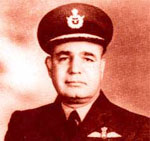INDIAN ARMED FORCES CHIEFS ON OUR RELENTLESS AND FOCUSED PUBLISHING EFFORTS

The insightful articles, inspiring narrations and analytical perspectives presented by the Editorial Team, establish an alluring connect with the reader. My compliments and best wishes to SP Guide Publications.

"Over the past 60 years, the growth of SP Guide Publications has mirrored the rising stature of Indian Navy. Its well-researched and informative magazines on Defence and Aerospace sector have served to shape an educated opinion of our military personnel, policy makers and the public alike. I wish SP's Publication team continued success, fair winds and following seas in all future endeavour!"

Since, its inception in 1964, SP Guide Publications has consistently demonstrated commitment to high-quality journalism in the aerospace and defence sectors, earning a well-deserved reputation as Asia's largest media house in this domain. I wish SP Guide Publications continued success in its pursuit of excellence.
- A leap in Indian aviation: Prime Minister Modi inaugurates Safran's Global MRO Hub in Hyderabad, Calls It a Milestone
- All about HAMMER Smart Precision Guided Weapon in India — “BEL-Safran Collaboration”
- India, Germany deepen defence ties as High Defence Committee charts ambitious plan
- True strategic autonomy will come only when our code is as indigenous as our hardware: Rajnath Singh
- EXCLUSIVE: Manish Kumar Jha speaks with Air Marshal Ashutosh Dixit, Chief of Integrated Defence Staff (CISC) at Headquarters, Integrated Defence Staff (IDS)
- Experts Speak: G20 Summit: A Sign of Global Fracture
Aspy Engineer (1912 - 2002)

‘If the IAF today is a service of which we are all proud, it is because of the high standards that you and your colleagues set from the start and have maintained ever since’
—J.R.D. Tata
In May 1930, a chance encounter happened between two young Indians at a remote airfield in Egypt during the course of a longdistance air race. J.R.D. Tata, who later became the Chairman of Air India, came to the assistance of Aspy Engineer, who was stranded with engine trouble. Decades later Engineer became the Chief of the Air Staff. A humble spark plug, graciously given, sealed the relationship between India’s future civil and military aviation leaders.
The Irani family of Karachi had the unique distinction of contributing four sons to the IAF. Aspy Merwan Irani, the eldest, was born in Lahore on December 15, 1912. At school, he was fascinated with mechanical things. So his friends gave him the nickname Engineer. He liked the name and officially adopted it. He also took to flying early in life.
In November 1929, Aga Khan of Karachi offered a prize of £500 for the first Indian to fly solo from England to India or vice versa. According to the rules of the Royal Aero Club, it must be a solo flight completed within six weeks from the date of starting. The prize will remain open for one year from January 1930. In March 1930, Aspy Engineer flew from Karachi to England as second pilot with a friend named R.N. Chawla in a de Havilland Gipsy Moth—a single engine, light aeroplane with rudimentary instruments and no radio aids. They were the first Indians to fly from India to England. On April 25, 1930, Aspy took off from London, in an attempt to fly the Gipsy Moth back to Karachi alone and claim the Aga Khan prize. However, when he landed at Aboukir Bay in Egypt, he noticed that a spark plug was not working. He discovered to his horror that he did not have a spare one and was effectively stuck. Fortunately for him, shortly thereafter, JRD Tata landed at the same airfield. Tata, also in a Gipsy Moth, was making the prize attempt in the reverse direction—from Karachi to London. He gave Engineer his spare spark plug and they resumed their race in opposite directions. Aspy reached Karachi on May 11, beating Tata by a few hours. Though a third contestant had finished the race a day before him, Aspy was declared winner since that contestant could not complete the journey within six weeks of commencement.





